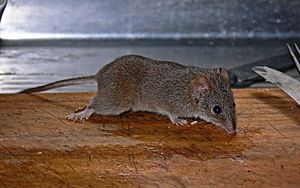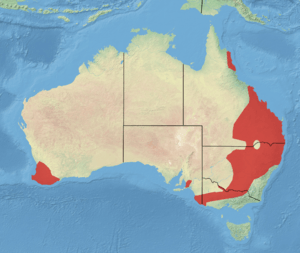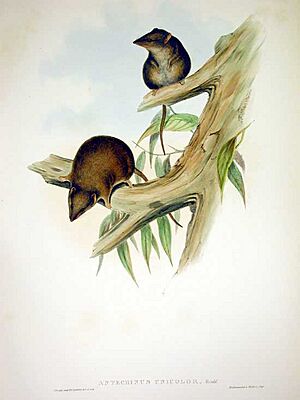Mardo facts for kids
Quick facts for kids Mardo |
|
|---|---|
 |
|
| Conservation status | |
| Scientific classification | |
| Genus: |
Antechinus
|
| Species: |
flavipes
|
| Subspecies | |
|
|
 |
|
| Distribution of the yellow-footed antechinus | |
The yellow-footed antechinus (Antechinus flavipes) is a small, shrew-like marsupial that lives in Australia. It is also known by its Aboriginal name, the mardo. These interesting animals have a unique life cycle. After mating, all male antechinus die, usually before they are one year old. This happens because their bodies get very stressed.
Contents
Discovering the Yellow-Footed Antechinus
The yellow-footed antechinus was first described in 1838. A scientist named George Robert Waterhouse gave it its scientific name. He studied a specimen found near the Hunter River in New South Wales.
The name flavipes means "yellow-footed". This name describes one of the antechinus's most noticeable features.
Antechinus Family Tree
The yellow-footed antechinus belongs to the family Dasyuridae. This family includes many meat-eating marsupials. It is the most widespread species in its group, the Antechinus genus.
Scientists recognize three different types, or subspecies, of the yellow-footed antechinus:
- Antechinus flavipes flavipes: Found in southeastern Queensland, New South Wales, Victoria, and South Australia.
- Antechinus flavipes leucogaster: Lives in southwestern Western Australia.
- Antechinus flavipes rubeculus: Found in northeastern Queensland.
What Does a Yellow-Footed Antechinus Look Like?
The fur color of the yellow-footed antechinus can change depending on where it lives. Generally, its fur is somewhat greyish. It often has a white ring around its eyes and a black tip on its tail.
Its head and shoulders are usually slate grey. This color blends into a reddish or yellowish fur. The fur is lighter on its chin and throat. It gets darker on its rump, sides, belly, legs, and feet. Antechinus from northeast Queensland have a deeper red color than those from southwest Australia.
Size and Features
Yellow-footed antechinus are typical in size for their genus. Their head and body together measure about 90 to 160 millimeters (3.5 to 6.3 inches). They weigh between 20 and 75 grams (0.7 to 2.6 ounces).
They have a pointed snout and short, wide feet. These feet are usually buff or yellow-brown, which gives them their name. They have short hair and a tail that is moderately long.
Daily Habits and Diet
Unlike some of its relatives, the yellow-footed antechinus is often active during the day. This makes it a diurnal animal.
Their diet mainly consists of small creatures. They eat invertebrates like insects, as well as eggs and nectar. Sometimes, they might even eat small vertebrates.
Where Do They Live?
The yellow-footed antechinus lives in different parts of Australia. You can find them from the Mount Lofty Ranges in South Australia up to Eungella in Queensland. However, they are not found along most of the coast of New South Wales and Victoria.
There are also separate groups in northeastern Queensland and southwestern Western Australia. Some groups are common in their areas, while others are harder to find.
Their Homes and Habitats
These animals can live in many different places. They are found in dry, arid scrubland and sclerophyll forests. In northern Australia, they also live in coastal heaths, swamps, and woodlands. In the far north, they can even be found in tropical vine forests.
Reproduction and Life Cycle
The yellow-footed antechinus has a very interesting life cycle. The mating season lasts for about two weeks. This happens in August for southern animals. For those in southern Queensland, it's in October. In north Queensland, it occurs in June or July.
After mating, all male antechinus die. This is due to their immune systems weakening from stress. Most females also die after they finish raising their babies. However, some females can live to have another group of babies the next year.
Raising the Young
Female antechinus can change how much they use torpor during pregnancy. Torpor is like a mini-hibernation where their body temperature and activity slow down. They do this to help their babies grow well, especially if conditions are tough.
Before breeding, both males and females use torpor often. They go into deep, long periods of rest. During the mating season, they use torpor less. Pregnant females still use torpor, but it's not as deep or as often. Females who are giving birth or feeding their young do not use torpor at all. Their bodies carefully control their temperature and energy during these important times.
- Learn more about the mardo on RadioNZ Critter of the Week, 10 February 2017.
See also
 In Spanish: Antequino de pies amarillos para niños
In Spanish: Antequino de pies amarillos para niños



